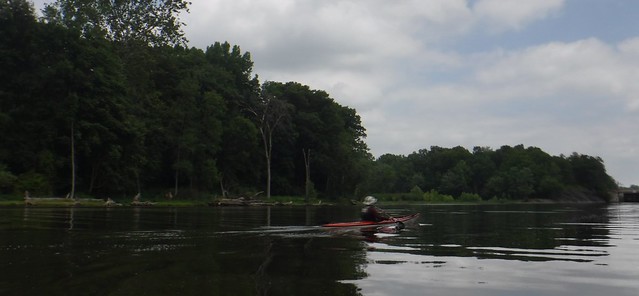At the start of another hot day we paddled from one shady spot to the next. Deer bounded into the woods from the side of the canal when we got close.
Previously, whenever we had seen fishermen we’d asked if they ate what they caught. We had fishing gear with us and looked forward to a fresh fish dinner. But the locals spoke of PCBs and recommended against it. Now, the fisherman told us the fish were fine. We’d have to start fishing.
In the distance I saw the telltale flash of a kayak’s paddles working on the water. Another kayaker was ahead of us! What if he was going the same way? What if she was on an expedition too? We had to catch up and find out.
We tried calling him on our radio, but no luck. We pushed hard. After much more time than I thought it would take, we caught up and met an old man on a sit-on-top kayak. He told us we’d find cows ahead.
When we passed the copse he had pointed at, we smelled but did not see them.
The town of Whitehall surrounds the final lock separating the Champlain Canal from Lake Champlain. It was there that Benedict Arnold founded the US navy to successfully fight for control of the lake in 1774.
We disembarked at a dock off of a park and found bathrooms in a museum celebrating the town’s history. On our way back to our boats we passed a parked Prius with home made wooden roof racks. About six months earlier I had lost two very nice sea kayaks off of store bought roof racks on I-95. I tried to learn the secret of constructing good roof racks for a Prius from their maker.
We completed the Champlain Canal and arrived on Lake Champlain. The southern end of the lake meanders much like a river. Large steel chanel makers, foundations for great osprey nests, marked the way. To outside the channel, thick vegetation in the water frustrated our paddling.
Back on the water, we descended the final lock to Lake Champlain. An osprey battled a smaller bird control of the heavens.
We were tired and pulled up to a boat ramp at the bottom of a small hillside cluster of houses. The nearest house’s windows had been boarded up. The structures purveyed an air of abandonment. A turtle walked along the edge of a stone wall, fell off with a clump, then slowly made its way down to the water.
We got back in our boats and continued on our way, only a short distance to the next town. A statue of Champ, the Champlain monster floated in the water, a floating log transformed into art.
At Benson’s landing we found a nice grassy lawn and permission to make camp on it. All the houses near the water were owned by one family. The folk next to our camp rented theirs from the family as summer lodging.
They invited us to join them for dinner and we swapped stories. They told us about the boy who belonged to the landlord. Until he was 14, he thought our hosts were his grandparents and spent as much time with them as he could when they were up for the summers. They weren’t, just nice neighbors. When the revelation came, they explained that they were his adopted grandparents.
The boy spent the summer pulling invasive species out of the lake.
We set our tent up without the fly. Stars are beautiful on a clear night.

